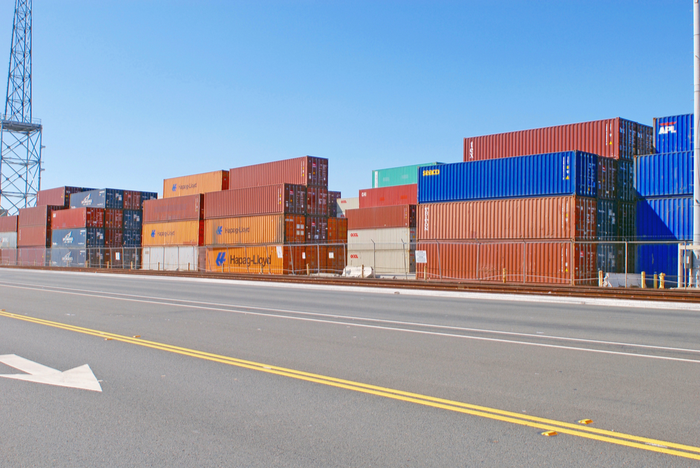By integrating their truck management systems with Long Beach Container Terminal’s system, truckers will be able to automatically make or change appointments without human intervention. Photo credit: Shutterstock.com.
Long Beach Container Terminal (LBCT) has launched a trucker interface program that is integrated directly with the truck management system of individual drayage companies, allowing truckers to automatically share real-time shipment data with LBCT for making or changing appointments without having to manually access the terminal website.
The Harbor Trucking Association (HTA) in Southern California says that by pushing data directly to drayage operators, LBCT will maintain its already port-wide-best turn times. It will also provide a model for other terminals that seek to further enhance the trucker experience by reducing the number of “trouble tickets” that terminals issue when there is a problem involving incomplete documentation or the payment of fees, HTA said.
“We would like to see more of this in the harbor,” said Weston LaBar, HTA’s CEO. “We hope it becomes the norm for the industry.”
If this type of application programing interface (API) technology is going to spread to the other 11 container terminal operators in Los Angeles-Long Beach, each of the terminals must work with the truckers — either directly, or through the truck management system providers that serve the drayage community — to update legacy systems. “It’s got to be a two-way relationship,” LaBar said.
LBCT’s truck turn times are already the best in the harbor. According to the HTA’s truck mobility data, the average truck visit time at LBCT was 34 minutes in June, compared with 77 minutes for all 12 terminals in the port complex. LBCT’s turn times the past four months have consistently been 36 minutes or faster, compared with the port-wide average of 83-84 minutes.
Making interaction easier
Now that LBCT has accomplished much of what it can do within the terminal to improve gate times, its goal is to make it easier for truckers to interact with the terminal on a daily basis, Anthony Otto, LBCT president, told JOC.com Friday. The API-based platform will do this by allowing the automatic creation of appointments as soon as containers become available; automatic cancellation of appointments if drivers encounter a problem, such as traffic congestion; and automatic grouping of appointments to facilitate dual transactions.
The platform will allow this functionality by integrating LBCT’s system directly with the system of the trucking companies, allowing LBCT to push information directly to the truckers so they don’t have to manually access the terminal system.
“This is true integration with truckers. They don’t have to go through a portal,” Otto said. “This is what the trucking industry has been begging for. They don’t have to screen scrape. It’s a direct data exchange.”
The benefit for LBCT is that with fewer truckers accessing its website to scrape information for its particular shipments, the system should be sped up for the smaller and mid-size truckers that still operate in a manual mode, he said. LBCT is already integrated with the three largest truck management system providers in the harbor — Compcare, Trinium, and Profit Tools. That allows the terminal to reach 35-40 percent of all trucking in the harbor, Otto said. LaBar added that some of the larger drayage operators also have the ability to integrate their systems directly with LBCT. Because the larger drayage companies no longer have to manually access the LBCT website, it will be freed up for smaller truckers who must still do so, he said.
Otto outlined a likely scenario for truckers who integrate their systems with LBCT’s. The system informs the trucker in advance when its containers will be discharged from the vessel, which will trigger the process of making appointments and grouping the appointments to facilitate time-saving dual transactions — i.e., dropping off an export container or empty and picking up an inbound container in the same trip. As soon as the container is discharged from the vessel, the trucker is automatically notified. If the trucker for whatever reason must suddenly cancel the appointment, LBCT is notified and the slot is opened up for other truckers. “This allows their system to communicate with ours, and ours with theirs,” he said.
Limiting two-hour-plus turn times
Although average turn times in the harbor are consistently above 80 minutes, the port-wide average is distorted by truck visits that exceed two hours. According to HTA mobility data, 17 percent or more of the truck calls port wide exceed two hours. By integrating the systems of the terminals and the truckers, the number of two-hour-plus visit times can potentially be reduced to 3 percent or less, LaBar said.
He added that the goal of the trucking community is for the systems of the terminal operators to be integrated with as many drayage operators as possible — either directly or through one of the truck management system providers — so that the systems of the terminals and the truckers automatically make decisions and carry out the transactions without human involvement.
“Everyone has to be open to updating legacy systems. No one loses out,” LaBar said.
All that is needed is an upfront investment by the parties, but once the investment is made, it will provide long-term benefits for everyone, he said.


